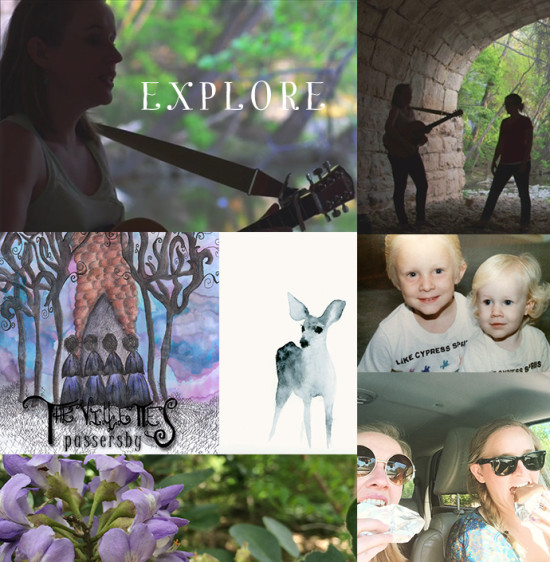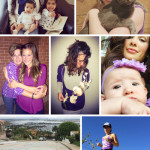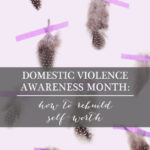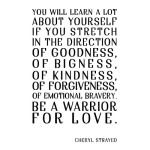This month marks Courtney’s one-year anniversary since joining the team of MB Behaviorists! In that time she’s become a weekly contributor with her Song of the Week posts, she’s interviewed several powerhouse women, and she’s written some great Miles posts about Scotland and Tyler, Texas. She’s even written movie reviews and fashion pieces, so I think it’s only appropriate that the word she’s chosen for us this month is “explore” because she’s always game to delve into a new subject and tackle any crazy project I throw at her!
In honor of Domestic Violence Awareness Month, Courtney shares with us a heartfelt journey she’s recently taken, starting in February of this year.
It’s been a year since I joined Model Behaviors. A year holds so much, yet oddly, not a whole lot. In a year I’ve started and quit a job, ended a two-and-a-half-year relationship, moved twice, gained some weight, let my hair grow out, traveled more than I thought I would, watched too much Netflix, released an EP with my band, started cooking for myself again, wrote the words I needed to, and went on walk after walk. Alone, by myself, I searched and searched for a new direction, or perhaps just any sense of direction. I said to myself, “Find out who you are. Name the things you’ve lost. Name the things you’ve gained. Explore all of it.”

This is why I chose “explore.” The last year of my little life has been full of it. In particular, I gained some insight into myself and how passionate I am about making a positive impact. Mostly in the realm of domestic and sexual violence and what I—as an individual—can do to move our culture in a more cognizant and progressive direction.
In February, one month after moving into a new place, two months after breaking up with my boyfriend, I got an email from SAFE. This is a nonprofit organization in Austin whose mission is to end domestic and sexual violence for everyone. They offer many different services to both men and women—counseling, survivor advocacy, legal advocacy, a hotline, community outreach, children’s services, supervising court-ordered visits, a shelter for survivors, plus a lot more. I’ve been a volunteer with SAFE since 2012, and the email told me there would be a fifteen-hour training program for anyone interested in doing public speaking. Before I could let myself think too hard about it, I wrote back that I wanted to participate in the training. I thought, “As a writer and a musician, I should work on upping my public speaking skills.” Plus, I wanted to distract myself from feeling sad about my breakup, and I figured I could do something productive for this organization I love while I was at it. What better way to accomplish all of this than to get some training to talk about the issues I’m super passionate about?
October is Domestic Violence Awareness Month. For a lot of us, when we hear “domestic violence,” words like “victim,” “anger,” “power,” and “control” pop into our minds. But there’s another word I’d like us to think about—prevention.
From my training and from people I’ve talked to during my time as a volunteer, we usually think of social services as something that comes after the fact, a way to help someone after the abuse has happened. I used to think this, too, but I’ve learned there are actually three different stages in a cycle of abuse where service can be provided. The stage we’re most familiar with is the third. This is when a survivor is trying to deal with the emotional trauma of abuse, trying to heal. Things like counseling, a shelter, and legal advocacy are useful during this stage.
The second stage happens while the abuse is occurring and immediately after. This type of service includes getting someone to safety, separating the abuser and the victim, making sure a hostile situation is diffused. A lot of social justice work is focused around this stage of service as well, especially if law enforcement is involved.
But surprisingly, the first stage of service we can offer comes long before any type of abuse occurs. This stage is called prevention. This is where we go directly to the root of the problem and teach people about patterns of abuse, where they originate, and how we can unlearn unhealthy and abusive behaviors. These past few months, with my public speaking, I focused on prevention.
After my training was over, my instructor asked me to take on a potentially challenging presentation. She asked me to teach a two-hour course about building and maintaining healthy relationships. The challenging part? My audience would consist of usually about 5-10 men between the ages of 25 and 65, predominately Black, followed by Hispanic, then White and Asian. Most of the men in my audience were transitioning from prison.
I’m going to be embarrassingly honest for a second. As much as I like to think of myself as open-minded and progressive, the idea of standing in front of this demographic and teaching them about healthy relationships put me way outside of my comfort zone.
My main questions were: How would I relate to these guys? How would they relate to me? How would I talk to them so as not to come across as condescending, and if I could manage all of this, why would they even listen to what I had to say? Wasn’t I just the privileged, inexperienced, White girl coming in to play savior to people of color, to criminals, to the uneducated? Isn’t that how they’d see me?
I spent the next five months first shadowing my instructor, then teaching with my instructor present, and finally teaching the class by myself. Every time I taught, I messed up. I’d stutter or say the wrong thing or make a reference that completely missed the mark with the men in my class. Every session, I got at least one piece of feedback that I’d chew on for hours, wondering who I’d left out, wondering who it was I didn’t reach.
But I also got to share stories about myself, about my family, about my experiences with healthy and unhealthy relationships. The longer I taught the class, the more I felt like I was starting to do something right. I’d hear someone say, “I can definitely use this,” or “This is the kind of stuff we all need to be learning.” Talking to these men about building healthy relationships planted a kernel of something in a few of them. Sometimes I’d even be lucky enough to get a group who shared, who opened up about things they’d experienced, and who told me they wanted to learn more. I can’t describe how awesome that felt.
By the time I taught my last class, I wasn’t asking myself those big questions anymore. I’d learned that for the most part, as long as I acknowledged the strangeness of me—privileged, White, and inexperienced—being their “teacher,” we could laugh it off and move on. I learned that when I truly listened to them and stopped worrying about our differences, we usually found some sort of common ground. Go figure, right?

So here’s where it gets hard.
In a survey taken in 2011 to measure the level of domestic violence in Texas alone, more than 26% of men said they’d experienced violence from an intimate partner at one point in their life and more than 37% of women said they’d experienced violence from an intimate partner as well (source). If we look at those percentages with the population of Texas, that’s over 5.3 million people who’ve experienced domestic violence in this state alone.
To take this a little closer to home, last year, SAFE responded to 12,482 hotline calls and provided face-to-face services to 4,980 adults and children impacted by domestic and sexual violence. They estimate that at any given time, approximately 60,000 Austinites are experiencing intimate partner violence. This is one city. One city in one state in one country.
At the beginning of my training, I was scared, but now I think I may have found a niche in this type of social justice work, and that is with prevention. I want to get to the root of the problem, reaching for the lofty goal of stopping domestic violence for good, of stopping it before it even begins. In the grand scheme of things, most of the men who were in my training sessions probably wouldn’t remember who I am, and most likely they won’t remember any of the finer points of my presentation. But it’s one step. It’s one tiny step in a huge, overwhelmingly large task to end domestic violence. Maybe I’m crazy, but I actually think our society can change. I actually believe humanity can do better, will do better. And I believe it happens one tiny, minuscule step at a time.
What’s more, I’m going to be there, taking those first unsure steps into the uncomfortable, for as long as I am able. I’ve got some exploring to do. Always.
To learn more about Domestic Violence Awareness Month, visit the National Network to End Domestic Violence website. Throughout the month, we are all encouraged to wear purple as a sign of unity and support, both for survivors and for the goal of ending domestic violence.
This Week’s Challenge
Post a picture of yourself wearing purple to show support for Domestic Violence Awareness Month! Be sure to tag us and use these two hashtags: #wellnessMB and #DVAM.
SAFE | Facebook, Twitter, YouTube







